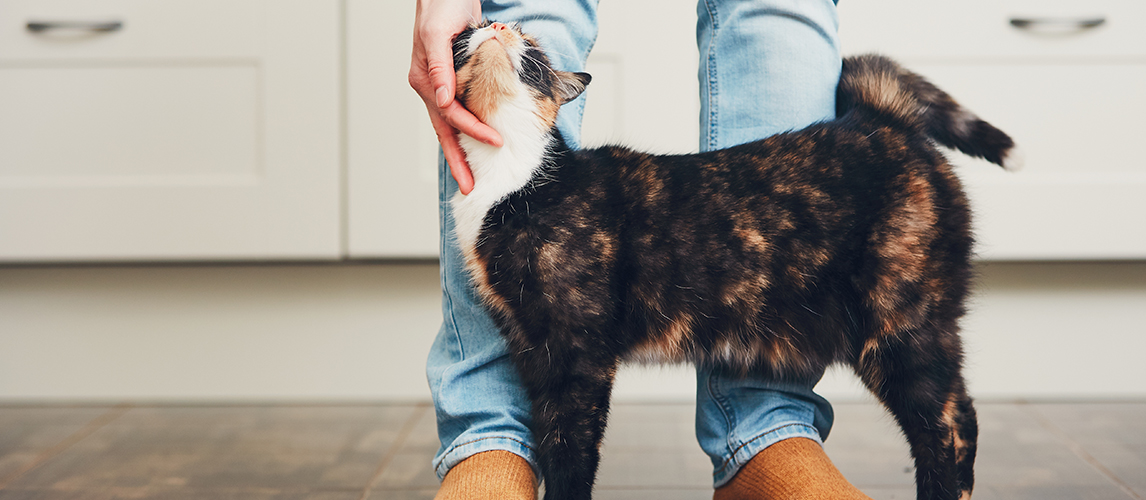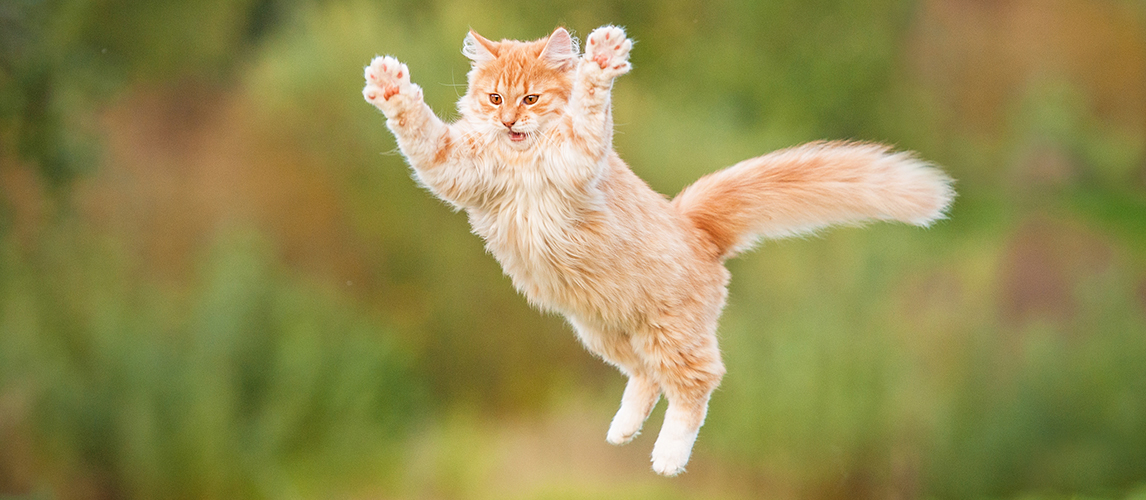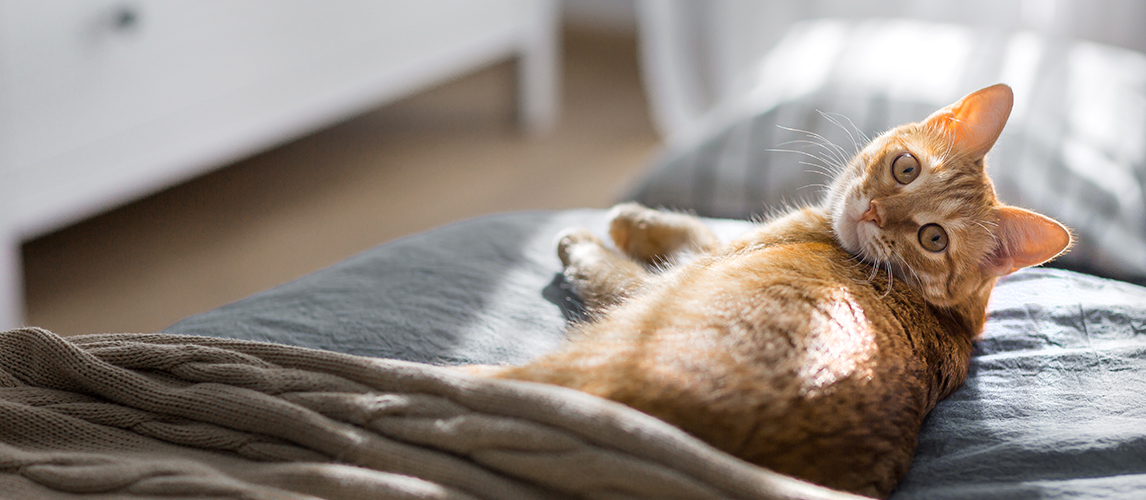The arched back of a black cat is an iconic Halloween image but if you are a cat owner, you know it is not just a scary pose but something your own pet is prone to do. But just why does your kit stretch out in such an exaggerated way? And is it a good thing or it is a sign that something is not quite right?
Cats are renowned for their agility and the vertebrae in their spines are incredibly flexible, meaning they can arch into quite an extreme pose. And understanding the body language behind such a position will help you to respond in the right way. To help you get to the bottom of your cat’s contortionist behaviors we ask: what does a cat’s arched back really mean?

Reasons Why Your Cat is Arching Their Back
Whether it is a sign of pleasure, contentment or stress, there’s always a reason behind your cat’s arched back. Here are the main answers to the question of why cats arch their back.
They Are Having a Good Stretch
In many cases, that arch pose is a sign that your feline is having a good old stretch. Just like humans, who will stretch out when we first wake up in the morning, cats will usually arch their back to stretch following a nap or longer sleep. Watch the stages of the stretch and you’ll know whether this is the reason for the back arch. Cats will typically start with the exaggerated back arch, then step forward, as they extend out their back as well as their paws and hind legs. With their muscles now limbered up, your kit should then simply walk away as normal.
They Are Responding to Danger
An arched back can also be your cat’s fear response, when she senses danger or harm. This can lead to that classic ‘Halloween’ pose, and the display is clearly one of fear and anxiety as it can often be accompanied by hissing or spitting. Another clear sign that this is a fear response will be something called ‘piloerection’, which sees the fur on their back, shoulders, ears and tail raised, as their muscles contract. We humans feel a similar fear response when the hairs stand up on our arms or back of the neck. The result is a distinct arched back and a sense that your cat is trying to make themselves look bigger, ready to see off any danger.
They Are Expressing Contentment
If your cat arches their back during a petting session, then chances are you have found their ‘sweet spot’ and the ‘cat with arched back’ pose is a natural response to feeling pleasure and contentment. If the arch is accompanied by a delicious purr and softly closed eyes, then you have hit the spot and have one happy puss on your hands!
They Are in Hunting Mode
An arched back accompanied by that distinct stealth walk all cats can do means your pet is most likely in hunting mode and preparing to stalk their prey. An arched back should give your cat a little more propulsion when they do finally pounce on the target of their attention – whether that’s a toy or the real thing. Kittens also exhibit this arched back spring when playing to practice their hunting skills.
They Are Marking Their Territory
A kitty with an arched back that also tends to position their butt against a wall or door, or even looks like they are about to urinate is, in fact, marking out their territory using their anal scent glands. You are most likely to see this behavior in unneutered cats as spayed cats are typically less territorial.

They Are Feeling Playful
A playful cat or kitten will often arch their back and pounce around. And if they then walk around your feet with their arched back, then this a lovely invitation to play. Their body language will be positive and there will be no signs of aggression, just a loving and confident cat wanting your attention.
They Are Actually Trying to Display Their Bottom
While this may sound a little unpleasant, when cats arch their backs it could be because they are deliberately trying to present their butt to you as a greeting! Cats will display their bottoms to each other as a friendly sign and if your kitty shows the same behavior to you, be pleased as it means they are comfortable in your company and want a little interaction.
They Are Experiencing Some Pain
One cause for an arched back you should always rule out is that it could be an indicator your pet is feeling unwell. Watch how your cat walks with their arched back and you should quickly be able to see whether pain is the cause of their exaggerated stance. If their arched back and one leg or more appear stiff or accompanied with one of the following symptoms, then something is not quite right:
- She doesn’t want to be touched or handled
- She appears lethargic or uncharacteristically aggressive
- She is agitated and becoming verbal
- You notice she is excessively licking or grooming herself
Reasons for a cat with arched back due to pain include arthritis, something lodged in their paw, kidney issues, heart problems, poor digestive health and even hyperthyroidism so if you are concerned, make an appointment with your veterinarian to get your kitty checked out.
Understanding Feline Body Language
It’s important to be clued into your pet’s body language when it comes to a cat with arched back so you don’t make any negative situation worse.
At a basic level when your cat arches their back, they are trying to make themselves look bigger, to either their prey or another cat. So, if the arch is accompanied with piloerection as well as hissing, spitting or scratching, then it is a warning. However, an arched back can also be a ‘peace offering’ as most cats don’t like confrontation, as well as a sign that they are relaxed and comfortable in your presence. Knowing the difference in body language between these scenarios will help you to assess why do cats arch their backs, and in your own cat’s case, give them the appropriate response.

And Finally, How you Should Respond
Cats exhibiting an arched back should be kept at a respectable distance until you are totally sure of the reason behind their arching pose. If there are clear signs of distress, anger or fear then don’t approach or attempt to pick up your cat until they are calm and settled as you could still be seen as a threat. Instead, try to work out the cause of their fear response and aim to eliminate it, so your cat has no need to keep up their defensive arch.
If there are clear behavior signs that your cat is actually content and even playful, then look at their body language before you respond as they may be asking for your attention or even inviting you to be their playmate.
And it goes without saying that if your cat arching back scenario is a clear sign of illness or pain, then when it is safe to do so, get your precious pet to the vet for a check-up, pronto.

